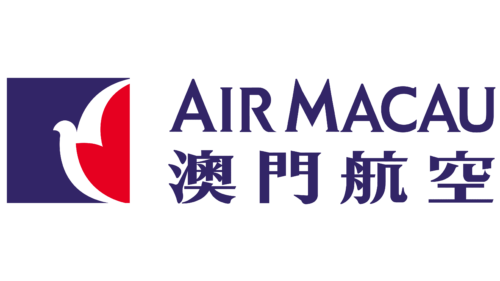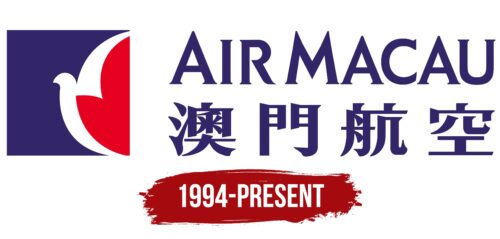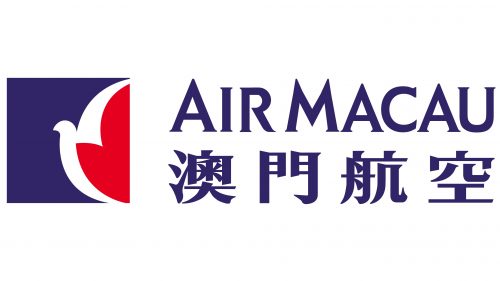The Air Macau logo skillfully combines elements of tradition and modernity to create a compelling and informative balance. This harmonious blend allows the airline to showcase its deep cultural roots while emphasizing its commitment to high-quality service and safety. It hints that travel goes beyond mere transit but offers the opportunity to be deeply enriched.
Air Macau: Brand overview
Air Macau was established on September 13, 1994, five years before Macau’s sovereignty was transferred to China. The airline’s founding was a calculated decision to advance air travel in Macau and assist the area’s expanding tourism sector. The principal investors were the Macau government (5%), TAP Air Portugal (20%), China National Aviation Corporation (51%), and local investors (24%).
The airline conducted its inaugural commercial flight from Macau to Beijing on November 9, 1995. Initially, the company had a fleet of three leased Airbus A321 aircraft, allowing it to cater to medium—and regional-haul routes.
In 1996 and 1997, the company’s first two years of business, it aggressively grew its route network. Routes were launched to nearby nations like Taiwan and South Korea, along with flights to important Chinese cities like Shanghai and Guangzhou. Macau’s crucial location as a link between China and the rest of the globe was reflected in this expansion.
China took over Macau’s sovereignty on December 20, 1999, after Portugal had done so. This incident had a big effect on the company’s operations and created new opportunities for the growth of air travel between Macau and mainland China.
In 2001, the airline became a regional member of Star Alliance, a worldwide aviation alliance. This partnership increased the company’s market share abroad, providing passengers additional travel possibilities.
2006, the business encountered severe financial difficulties due to intense competition and growing fuel costs. This led to a reorganization that included cutting expenses and improving the route network.
In 2009, Air China raised its airline ownership to 80.9%, taking control of the business. This adjustment boosted the company’s position in the market and brought it closer to being in line with Air China’s strategy.
From 2010 to 2015, the business completed a major fleet overhaul. Acquiring new Airbus A320 and A321 planes increased operational effectiveness and the caliber of passenger service.
The airline opened new destinations in Southeast Asia in 2016, including Bangkok and Hanoi, as part of its ongoing effort to broaden its international route network. Macau’s increasing prominence as a business and tourism hub in the region was mirrored in this expansion.
2018 saw the firm deal with heightened competition from local high-speed rail lines and low-cost carriers. As a result, the airline concentrated on enhancing customer satisfaction and streamlining its route system.
As it commemorated its 25th anniversary in 2019, the company reaffirmed its position as a major participant in the aviation sector and a vital conduit connecting the area to the outside world.
Meaning and History
What is Air Macau?
Air Macau proudly serves as Macau’s flagship airline, exemplifying the dynamic blend of Chinese and Portuguese influences that characterize the region. Since its inception, the airline has written a new chapter in Macau’s rich history, providing more convenient connectivity between this dynamic Special Administrative Region and the world. The company has been instrumental in enhancing Macau’s global accessibility. It has consistently expanded its network of destinations, fostering stronger connections to major cities in Asia and beyond.
1994 – today
Air Macau has chosen a national-style logo with two iconic elements, the dove and the lotus, featured on the national emblem. These elements are harmonized with each other: the dove’s spread wing perfectly matches the flower’s outline. The background for these elements is a dark blue square. On the right is a two-level inscription of the airline’s name in the local dialect and English. The upper line is written in Chinese characters, and the second is in the English alphabet. The color scheme includes a combination of red, blue, and white.
The logo’s use of the dove and lotus carries cultural symbolism, as these elements are important in local tradition. The dark blue square background accentuates the other colors, creating a striking contrast. The bilingual lettering highlights the breadth of the airline’s reach, serving local and international travelers. The red, blue, and white colors are visually distinctive and culturally symbolic, adding another layer of depth to the logo design.
FAQ
Who is Air Macau partners with?
Based in Macau, Air Macau has partnered with several well-known airlines to improve its network and provide smoother travel options. These agreements help Air Macau reach beyond its usual routes by sharing flights with its partners. Here’s how each partnership works:
- Air China: This partnership is key because Air China is a major shareholder of Air Macau. The agreement lets passengers access a wider network in mainland China and other areas, using Air China’s extensive routes from Beijing and other big cities.
- All Nippon Airways (ANA): By teaming up with ANA, Air Macau offers more flight choices to Japan. ANA has a strong market presence in Japan, which improves connections between Macau and various Japanese cities. This benefits both business and leisure travelers.
- Asiana Airlines: This partnership opens up more routes between Macau and South Korea. Asiana’s network helps travelers reach important South Korean cities like Seoul, going beyond what Air Macau directly offers.
- Philippine Airlines: This agreement expands Air Macau’s network to the Philippines, making travel between Macau and Filipino cities easier. It’s especially helpful for the many Filipino expats in Macau and tourists visiting the Philippines.
- Shenzhen Airlines: Partnering with another Chinese airline, Shenzhen Airlines, strengthens connections between Macau and Shenzhen and other routes. This is vital for enhancing travel flexibility for passengers around the Pearl River Delta.
- Thai Airways International: By working with Thai Airways, Air Macau improves its connections to Thailand, a major Asian destination. This partnership helps tourists and business travelers move between Macau and cities like Bangkok.
These partnerships boost Air Macau’s presence in these regions and offer passengers more versatile travel options, strengthening Air Macau’s position in the competitive aviation market.
What is the IATA code of Air Macau?
Air Macau, officially named Air Macau Company Limited, is identified by the IATA code NX. This code helps streamline processes like ticketing and baggage handling in airports worldwide. Air Macau uses an ICAO code, AMU, mainly used in air traffic control and other airline operations. The airline is based in Macau, a part of the China & North Asia region. Additionally, Air Macau has an airline code 675, which helps identify the airline in various aviation and travel databases, like its IATA and ICAO codes. These codes are crucial for managing air travel efficiently and accurately worldwide.
What kind of plane is the Air Macau?
Air Macau uses a variety of Airbus planes that are tailored to different flight needs. The fleet includes two Airbus A319-100s, which are small and ideal for short to medium trips. The airline operates six Airbus A320-200s, known for their versatility and slightly larger size than the A319s.
Air Macau has three Airbus A320-200neos, a newer model that is more fuel-efficient and better for the environment. The largest planes in the fleet are the ten Airbus A321-200s. These have more seats and are used on busier routes.
Air Macau’s planes show a commitment to using modern, efficient aircraft that help keep costs down and reduce environmental impact while still meeting the needs of their routes.
Is Air Macau part of Star Alliance?
Air Macau, Macau’s flag carrier, is an affiliate member of the Star Alliance. This means it is connected to the alliance through its partnership with Air China, a full member. As an affiliate, Air Macau offers benefits like codesharing and passenger perks with other airlines in the alliance.
Being part of the Star Alliance improves Air Macau’s services and expands its network to more destinations globally. Like other airlines in the alliance, passengers can earn and use frequent flyer points on flights with Air Macau. Air Macau’s affiliation is valuable because Macau is a key international tourist spot. The partnership helps improve the airline’s services by meeting international standards, benefiting passengers and operations.





